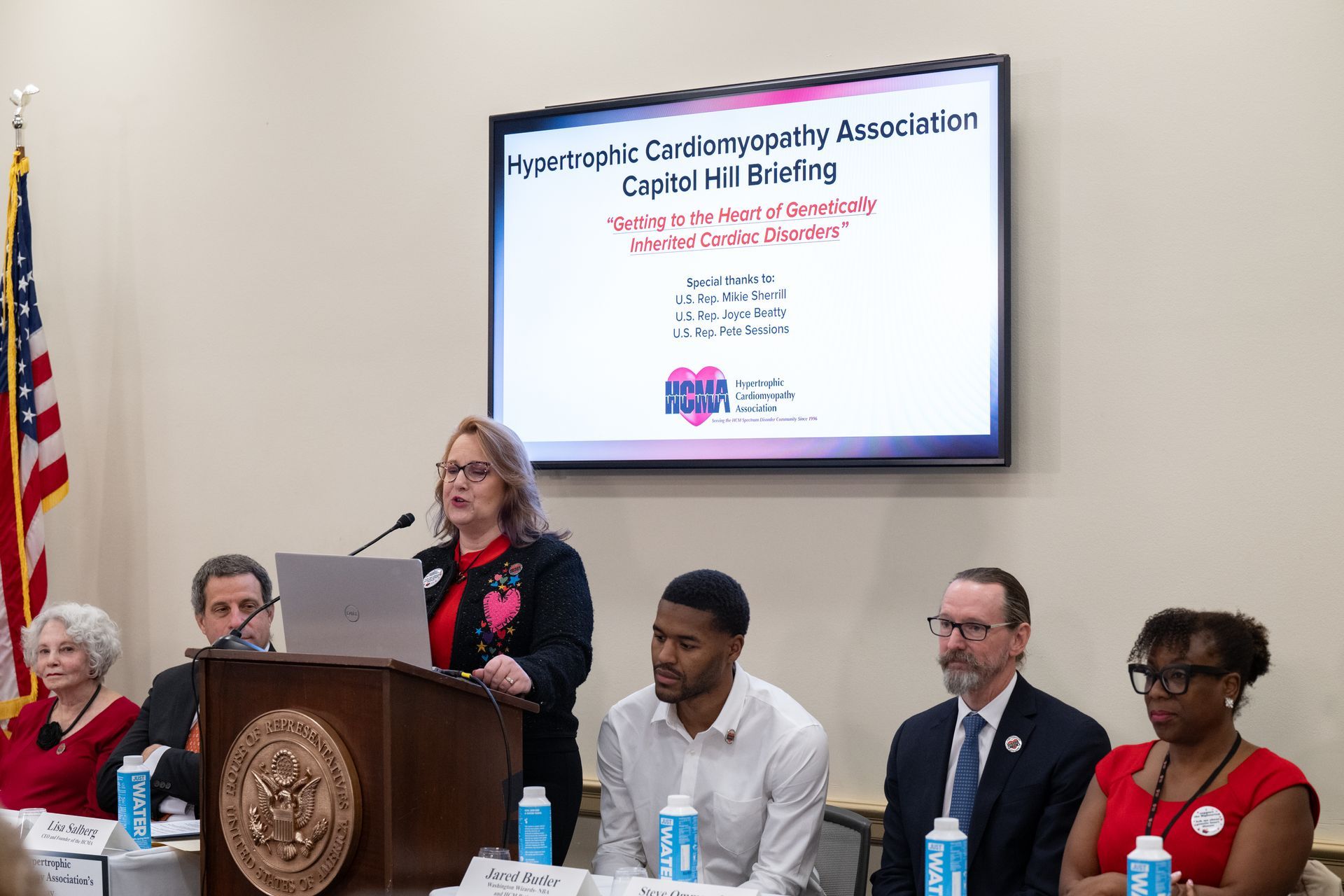RASopathies:
Noonan Syndrome Spectrum Disorders
Developmental Disorders
What are RASopathies?
RASopathies are rare and include several different conditions. The most common is Noonan Syndrome. These syndromes are typically found in childhood, but later diagnosis is possible. Most RASopathy patients (up to 80%) have heart problems, including congenital heart defects and "HCM". Other organs and systems are affected, such as the face, head, and kidneys. Those with RASopathies may have slow growth, developmental delay, and bleeding disorders.

The group of conditions called RASopathies are developmental disorders. They are caused by mutations in genes linked to the RAS/MAPK pathway. These disorders occur in about 1 in 1000 to 1 in 2500 live births. The most common RASopathy is Noonan Syndrome, so they're called Noonan Syndrome Spectrum Disorders. These syndromes affect many body systems, and heart problems are often part of that.
What are the different RASopathies?
The RASopathies include Noonan Syndrome with multiple lentigines (NSML, formerly LEOPARD syndrome). Also, Cardiofaciocutaneous Syndrome (CFCS), Mazzanti Syndrome (MS), Costello Syndrome (CS), Type 1 Neurofibromatosis, and Legius Syndrome. Other related syndromes are being investigated.
How are RASopathies similar to each other?
Each RASopathy has a unique clinical type, but they have overlapping signs and symptoms. These include slow growth, changes in the bones of the face and head, undescended testicles, cognitive deficits, kidney problems, bleeding disorders, and congenital heart defects.
What causes RASopathies?
Mutations in various genes can cause RASopathy. More than 10 genes are associated with Noonan Syndrome alone. Some of these mutations lead to a higher chance of hypertrophic cardiomyopathy (HCM). Others have a higher chance of learning disabilities or growth problems.
Other heart problems in RASopathies
Congenital heart defects (CHD) are often part of RASopathies. These include pulmonary valve stenosis, mitral valve problems, ASD (hole between the atria), VSD (hole between the ventricles), AVSD (hole in the center of the heart), aortic coarctation (narrowing of the artery leaving the heart), and coronary artery issues.
Monitoring heart problems in RASopathies
EKG/ECG and Holter Monitor
Abnormal heart rhythms are common in RASopathies. Regular evaluations using EKG and Holter or ambulatory monitoring are important.
Echocardiogram
It's important to have regular echocardiograms. They can detect issues with the heart anatomy and LVOTO. They can also detect heart failure. How often patients need an echo depends on their individual hearts. Your cardiologist will tell you how often you need an echo.
LVOTO is common among patients with RASopathies. This may be due to problems other than LVH. Things like issues with papillary muscles, or abnormal mitral chordae. Fibrous tissue can cause midventricular obstruction. The mitral valve leaflets can be long in patients with R-HCM. Displacement of the papillary muscles may pull the mitral valve out of alignment. These causes of obstruction can be seen on an echo.
Hypertrophy in both the right and left ventricle may be a clue that this is R-HCM. Thickening in the right ventricle may cause right ventricular outflow tract obstruction.
MRI/CMR
Cardiac MRI (CMR) can measure the thickness of the septum and walls of the heart more accurately than echo. Late gadolinium enhancement shows how much fibrosis (scarring) is in the heart.
Genetic Testing and Family Screening
Genetic testing helps to understand which RASopathy is present and what problems it may cause. It can help screen family members of the patient so they know if they are affected. It can also help people make choices about having children. When someone is diagnosed with RASopathy, their family will be offered genetic testing. A genetic counselor can help your family understand your genetic information.
Medical Management
Medical therapy is the first option in patients with R-HCM.
Nonvasodilating beta-blockers and diuretics can reduce congestive status and heart failure (HF) symptoms. Be careful not to overdo diuretics as they can cause low blood volume, which can increase LVOTO. If beta-blockers have too many side effects, nonvasodilating calcium channel blockers can be tried.
There are some reports of low heart rate and worse HF in infants with LVOT gradients over 100 mmHg. Verapamil could be harmful to this group. In patients who still have symptoms on beta-blockers, disopyramide can help reduce obstruction.
In some cases, rapamycin or MEK1 inhibitors may reduce LVH and should be considered.
Myectomy Surgery
In cases where obstruction can't be reduced by medications, septal myectomy surgery is an option to remove the obstruction.
Heart Transplant
Heart transplant is rarely done in patients with NS. It may be considered in patients with severe HF symptoms who don't respond to medications. If a heart transplant is needed and the wait is too long, especially in infants, the outcome is often poor. Evaluation for heart transplants should be done as early as possible in R-HCM patients with severe heart failure.
Clinical Trials
There are ongoing clinical trials of medications for heart problems in RASopathies. A small trial with trametinib had promising results, reversing LVH in two NS patients. More studies are on the horizon.
How are RASopathies like HCM?
HCM is the most common heart problem in RASopathies after congenital heart defects (CHD). Worse outcomes happen when heart problems start early in life. RASopathies may cause up to 18% of childhood HCM. In those under 1 year old, they make up about 42% of the cases. RASopathies with HCM have complications in many other body systems. Mutations on some genes (especially RAF1) make HCM very likely. Typical HCM is most often diagnosed in adolescence or later. Rasopathy HCM is usually diagnosed in early childhood.
HCM in Noonan Syndrome
HCM is part of Noonan syndrome in about 20-30% of cases. About a third of cases have LVOTO. Classic HCM rarely has CHD, but this is common in Noonan with HCM. Asymmetric or concentric LVH can be seen in HCM with Noonan syndrome and in classic HCM. Apical HCM has not been reported in Noonan syndrome.
HCM in Noonan Syndrome with Multiple Lentigines
HCM is found in about 85% of patients with NSML. Left ventricular outflow tract obstruction (LVOTO) happens in up to 40% of cases. Both left and right ventricular hypertrophy is seen in about half of the patients. HCM is often diagnosed in early infancy and is usually seen before the lentigines appear.
HCM in Costello Syndrome
About 65% of those with CS have HCM. Of these, about 40% also have CHD. Up to 60% have LVOTO. Most have thickening in the left ventricular septum near the aorta. Some have even thickening around the left ventricle (concentric). A few have thickening in both the right and left ventricles (biventricular). Up to 25% of CS patients with HCM need septal myectomy to relieve LVOTO. More than 50% of infants with CS have fast heart rates in the upper chambers of the heart (the atria). This is easily managed with medications and usually improves with age. Some CS patients develop atrial fibrillation or atrial flutter later in life. Abnormal beats in the ventricles are not common in CS.
HCM in Cardiofaciocutaneous Syndrome
About 40% of patients with CFCS have HCM during infancy. This can progress quickly, leading to a need for heart transplant or death. In many cases, the HCM is mild and easily managed. These patients often have CHD such as pulmonary valve stenosis, atrial septal defect (ASD), or ventricular septal defect (VSD). Abnormal heart rhythms are unusual in these patients but can happen.
Implications of HCM in RASopathies
HCM changes the outcome in patients with NS Spectrum Disorders. Severe heart problems increase the risk of death in young patients. The risk of early death is higher if there is heart failure during the first 6 months of life. Low cardiac output and significant diastolic dysfunction also increase the risk.
The outcomes of children affected by Rasopathy HCM (R-HCM) are different from typical HCM. Patients with R-HCM can be severely affected as babies. They are more likely to need septal myectomy or pulmonary valve repair. They don’t often have an increase in left ventricular hypertrophy (LVH) during adolescence and young adulthood. Patients with R-HCM have a similar amount of fibrosis (scarring in the heart) to those with typical HCM. Fibrosis is already present early in R-HCM. In typical HCM, myocardial disarray and fibrosis develop over time.
In 5% to 10% of cases, R-HCM is linked to severe heart problems, especially for infants with heart failure. Outside of these cases, symptoms tend to improve over time, and progression of LVH is less common in R-HCM. The left ventricular wall thickness can even decrease. Unlike typical HCM, this decrease isn’t associated with dilation of the heart walls.
HCM is the main cause of sudden cardiac death (SCD) among adolescents and young adults. Sustained ventricular tachycardia (VT) is common in R-HCM and is related to the risk of SCD. The overall risk of SCD appears lower in R-HCM. A history of VT, cardiac arrest, fainting, or massive LVH has been associated with a higher risk of SCD. Those with these risk factors may require an ICD. Risks for SCD should be evaluated carefully in children. LVOT gradient does not seem to be associated with SCD in R-HCM.
Citations:
Hypertrophic Cardiomyopathy in RASopathies. Heart Fail Clin. 2021 Oct 25;18(1):19–29.

 Translate
Translate